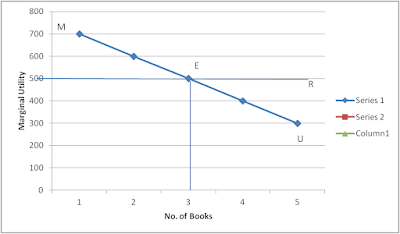Consumer’s Equilibrium : in Single Commodity
Through Cardinal Utility Approach :
Question : State the conditions of consumer’s equilibrium in terms of Utility Analysis.
Question : Using the Utility Approach, discuss how a consumer attains equilibrium ?
Question : Explain why consumer’s equilibrium is attained when the marginal utility of a product is equal to its price.
Consumer’s Equilibrium : through Cardinal Utility Approach :
Condition of Equilibrium:
- A consumer is said to be in equilibrium when he spends his given income on the purchase of different goods and services so as to maximise his total utility.
- Equilibrium is the ideal position, towards which consumer will like to move.
- A utility maximising consumer will be in equilibrium when he purchases that much quantity of the commodity where the marginal utility of the commodity equals to its price
MUx = Px
Where MUx = marginal utility of a commodity ‘x’
Px = price of the commodity ‘x’
Assumption :
- The consumer is rational, he aims to maximise his total utility from his purchase.
- The utility approach makes the assumption of cardinal utility. Here cardinal utility means that utility that a consumer derives from a unit of commodity can be measured in absolute terms. Utility can be measured in monetary terms i.e., utility of one unit of a commodity equals the amount of money, the consumer tends to pay for it.
- The law of diminishing marginal utility operates.
- Consumer’s income is given and remains constant.
- Prices of other commodity are assumed to be given.
Explanation of Consumer’s Equilibrium :
- For a utility maximising consumer, he should spend his given income so as the marginal utility of the commodity equals to its price,
MUx = Px
- Both the good and the money he spends (price) has utility for the consumer, thus he can either spend the money income and purchase the good or keep it with himself.
- If MUx > Px , utility gained from the given unit is more than the price paid for it, hence a rational consumer will consume more so that the MU falls to be equal to the price.
- Likewise, if MUx <Px , utility gained from the given unit is less than the price paid for it, hence a rational consumer will consume lesser quantity so that the MU rises to be equal to the price.
Numerical Explanation :
Marginal utility of Shirts :
|
SN |
Unit of Shirts |
Marginal Utility (inRs) |
|
1. |
1 |
700 |
|
2. |
2 |
650 |
|
3. |
3 |
600 |
|
4. |
4 |
500 |
|
5.. |
5 |
350 |
Explanation:
- In the given graph MU for the first shirt is Rs. 700 .
- When consumer buys additional units of shirt, the marginal utility goes on diminishing.
- If the price of the shirt is Rs. 600, a consumer will be in equilibrium when he purchase three shirts because MU of 3rd shirt ( Rs 600) is equals to the price of the shirt (Rs 600).
- At any point above E, MU> P e.g., the 2nd shirt where MU is Rs 650 and Price is Rs 600. Therefore the consumer can increase his total utility by purchasing 2nd shirt.
- Similarly, at any point below point E, MU < P , since price is higher than utility derived, the consumer will not like to purchase 4th shirt because MU = 500 while Price = 600.
- Thus, point E is the Point of Equilibrium where MU = P .
Question : The following table shows the MU derived from the purchase of books. The price of the book is Rs 500. Draw a diagram to explain consumer’s equilibrium where MU = P.
|
SN |
NO. Of Books |
Marginal Utility |
|
1. |
1 |
700 |
|
2. |
2 |
600 |
|
3. |
3 |
500 |
|
4. |
4 |
400 |
|
5. |
5 |
300 |
Answer: While plotting the graph between the MU and no. of Books , the point of equilibrium is found at point E.
Explanation :
- In the given table, when the graph is plotted between the MU of books and no. of books, a downward curve is obtained indicating the law of diminishing Marginal Utility.
- Curve MU and price line P intersect at point E (Point of Equilibrium) where MU = P (Rs. 500).
- Any point above point E , shows MU > P. E.g., 2nd book gives him satisfaction equals to Rs. 600 while price is Rs. 500. The consumer can increase his purchase to maximise total utility and buy 2nd book.
- Any point below point E , MU < P , Example 4th book gives him satisfaction of Rs 400 while the price is still Rs. 500. Hence, the consumer tends to maximise his total utility buy purchasing less.
Also read –


